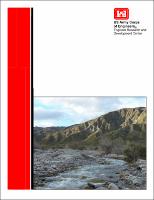Please use this identifier to cite or link to this item:
https://hdl.handle.net/11681/5327Full metadata record
| DC Field | Value | Language |
|---|---|---|
| dc.contributor.author | Lichvar, Robert | - |
| dc.contributor.author | Finnegan, David C. | - |
| dc.contributor.author | Ericsson, Michael | - |
| dc.contributor.author | Ochs, Walter J., 1934- | - |
| dc.date.accessioned | 2016-03-21T16:36:43Z | - |
| dc.date.available | 2016-03-21T16:36:43Z | - |
| dc.date.issued | 2006-02 | - |
| dc.identifier.uri | http://hdl.handle.net/11681/5327 | - |
| dc.description | Technical Report | - |
| dc.description.abstract | The U.S. Army Corps of Engineers (COE) is actively involved in floodplain management and regulation of dry wash floodplains in the western United States. The COE also regulates “Waters of the United States” (WoUS) under Sec. 404 of the Clean Water Act by determining the extent of surface indicators related to “ordinary” flood discharges known as Ordinary High Water Marks (OHWM). The return interval for inundation to the WoUS boundary is not well understood in the arid West. COE hydrologic models require detailed site information for rainfall and stream flow characteristics, as well as on-site surveys to determine channel morphology, width, fluvial patterns, slope, and other physical attributes. The focus of this research is to quantitatively correlate field indicators to flood return inundation levels in support of identifying the events that best represent the extent of the “ordinary” high water using high-resolution topography acquired through Light Detection and Ranging (LiDAR). The NASA’s Airborne Topographic Mapper (ATM) was the source of high-resolution topographic data for several stream reaches throughout the Mojave Desert, California. This research showed that field indicators commonly used to delineate the extent of the OHW are distributed across the entire floodplain and are not associated with a particular level of event. However, a consistent pattern of geomorphic signature and vegetation density is highly correlated to moderate flood events. A hypothesis and a working model were developed to explain the distribution pattern of various OHWM indicators and the repeating geomorphic signature. | - |
| dc.publisher | Cold Regions Research and Engineering Laboratory (U.S.) | - |
| dc.publisher | Engineer Research and Development Center (U.S.) | - |
| dc.relation | http://acwc.sdp.sirsi.net/client/en_US/search/asset/1001678 | - |
| dc.relation.ispartofseries | ERDC/CRREL ; TR-06-5. | - |
| dc.subject | River channels--Southwestern States | - |
| dc.subject | Floodplain management--Southwestern States | - |
| dc.subject | Arid regions--Southwestern States | - |
| dc.title | Distribution of Ordinary High Water Mark (OHWM) indicators and their reliability in identifying the limits of "Waters of the United States" in arid Southwestern channels | - |
| dc.type | Report | en_US |
| Appears in Collections: | Technical Report | |
Files in This Item:
| File | Description | Size | Format | |
|---|---|---|---|---|
| CRREL-TR-06-5.pdf | 1.92 MB | Adobe PDF |  View/Open |